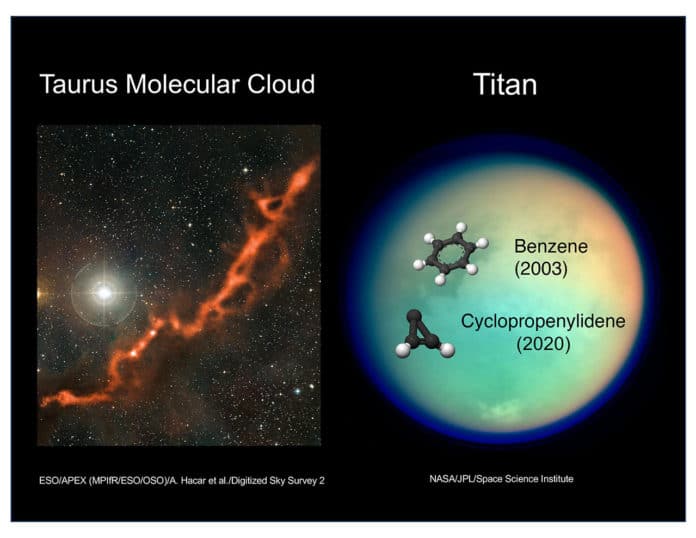Titan is the largest moon of Saturn. It is an intriguing world, whose atmosphere is made mostly of nitrogen. At the Titan surface, the atmospheric pressure is about 60 percent greater than on Earth—roughly the same pressure a person would feel swimming about 50 feet (15 meters) below the surface in the ocean on Earth.
In recent, NASA scientists discovered a molecule in Titan’s atmosphere. The molecule was not detected in any other atmosphere before.
The discovery of the molecule called cyclopropenylidene, or C3H2, was made using a radio telescope observatory in northern Chile known as the Atacama Large Millimeter/submillimeter Array (ALMA).
The molecule is made of carbon and hydrogen while sifting through a spectrum of unique light signatures collected by the telescope; these revealed Titan’s atmosphere’s chemical makeup by the energy its molecules emitted or absorbed.
Scientists say that this simple carbon-based molecule may be a precursor to more complex compounds that could form or feed possible life on Titan.
Conor Nixon, a planetary scientist at NASA’s Goddard Space Flight Center in Greenbelt, Maryland, said, “When I realized I was looking at cyclopropenylidene, my first thought was, ‘Well, this is unexpected.’
The molecule was before observed in pockets throughout the galaxy, but its discovery in an atmosphere was a surprise. That’s because cyclopropenylidene can react easily with other molecules; it comes into contact with and forms different species.
Melissa Trainer, a NASA Goddard astrobiologist, said, “We think of Titan as a real-life laboratory where we can see similar chemistry to that of ancient Earth when life was taking hold here.”
“We’ll be looking for bigger molecules than C3H2, but we need to know what’s happening in the atmosphere to understand the chemical reactions that lead complex organic molecules to form and rain down to the surface.”
Given that it’s a rare find, scientists are trying to learn more about cyclopropenylidene and how it might interact with gases in Titan’s atmosphere.
Michael Malaska, a JPL planetary scientist who worked in the pharmaceutical industry before falling in love with Titan and switching careers to study it, said, “It’s a very weird little molecule, so it’s not going be the kind you learn about in high school chemistry or even undergraduate chemistry. Down here on Earth, it’s not going be something you’re going to encounter.”
“But, finding molecules like C3H2 is important in seeing the big picture of Titan: “Every little piece and part you can discover can help you put together the huge puzzle of all the things going on there.”
Journal Reference:
- Conor A. Nixon et al. Detection of Cyclopropenylidene on Titan with ALMA. DOI: 10.3847/1538-3881/abb679
